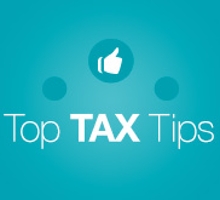What Does Your Tax Code Mean?
 Does your tax code look like a foreign language to you? We thought it may be useful to explain in simple terms how you can understand what your tax code means and how you can work out what your tax-free personal allowance is.
Does your tax code look like a foreign language to you? We thought it may be useful to explain in simple terms how you can understand what your tax code means and how you can work out what your tax-free personal allowance is.
So, what is a tax code? Your tax code is a short code worked out by HMRC that’s then sent over to your employer or pensions provider so to ensure the correct amount of income tax (PAYE), or other taxes, are taken from your salary or pension each month.
Read more
How to Save Money on Your Self-Assessment Tax Return
 The new year is now well underway, which can mean only one thing for self-employed small (and medium-sized) business owners; it’s time to finally get around to submitting your self-assessment tax return.
The new year is now well underway, which can mean only one thing for self-employed small (and medium-sized) business owners; it’s time to finally get around to submitting your self-assessment tax return.
Your 2013-14 self-assessment tax return is due at midnight on 31 January 2015, as is your final payment of any tax due.
There are dozens of ways to save money on your tax return year after year; some of the most rewarding of which are summarised below:
Maximise Your Tax-Free Personal Allowance
If you’re married or in a civil partnership you can maximise your joint tax-free personal allowances by transferring income between each other so to ensure neither of your personal allowances go unused.
Your personal allowance for the current tax year (2014-15) is set at £10,000, meaning should your spouse earn less than £10,000 a year, they can transfer the unused portion of their personal allowance to you, allowing you to benefit from a slight tax break on this amount.
Use Your ISA Allowance
In the last twelve months Individual Savings Accounts (ISAs) have been completely transformed.
Whereas before you could only use half of your tax-free ISA allowance as a cash investment (the other half having to be placed into stocks and shares), under the new rules you can save up to £15,000 into your ISA each year, with a choice as to whether you want the full amount to consist of cash, stocks and shares, or a combination of both.
Invest In a Pension Scheme
Investing into a personal pension scheme (or one organised by your place of work) allows you to save money on your tax return by way of tax relief of up to £40,000 a year.
It’s possible to opt to push forward your allowance for up to three years, an option that’s of considerable use should you currently not wish to invest into a scheme for whatever reason, but you’re confident you’ll wish to do so in a few years from now. If you do have the money to invest now, however, you’re encouraged to make the investment (and benefit from the tax relief) immediately.
Use Your Capital Gains Tax Exemption
Chances are you won’t need to think twice about your Capital Gains Tax (CGT) exemption limit if you’re not planning on selling assets of particular significance (and expense).
If you do choose to sell such an asset, however, you can make best use of your Capital Gains Tax exemption limit (set at £11,000 for 2014-15) by transferring certain assets to your partner (or becoming joint-owners) ahead of selling it on.
Maximise Your Annual Investment Allowance
The Government has been increasing and decreasing the Annual Investment Allowance (AIA) for years now, with the most recent increase; from £250,000 to £500,000 in place until 31 December 2015.
Designed to stimulate business investment across the economy, this allowance can be deducted from your taxable profits. According to Chancellor of the Exchequer George Osborne, “99.8% of businesses will get a 100% investment allowance… [meaning] almost every business across Britain will pay no upfront tax when they invest in the future.”
Place Investment Capital in EIS/SEIS Schemes
If you’ve not done so already, placing investment capital into the Enterprise Investment Scheme (EIS) and Seed Enterprise Investment Scheme (SEIS) allows you to receive healthy tax reliefs while helping small business owners across the country.
Investors in the EIS should expect to receive up to 30% tax relief on income tax, Capital Gains Tax, and inheritance tax. Investors in the SEIS have the potential to receive up to 78% in tax relief (50% income tax relief on invested funds, and 28% Capital Gains Tax relief).
Claim for Capital Losses
You can claim for capital losses by carrying them forward into the next tax year, and therefore reducing your Capital Gains Tax over time. These losses will be offset against your profits from the same trade.
You may also claim for capital losses by carrying back any trading losses; offsetting them against other income in the year. Unlike carrying your loss forward, however, which happens without any input from you, carrying back trading losses is a fairly complicated process and you’re therefore encouraged to speak with your accountant before carrying them back.
Maximise Your Wear and Tear Allowance
If you rent furnished properties you’re legally within your right to claim a wear and tear allowance each year, an allowance (currently set at 10% of the relevant rental amount) that allows you to offset some of the ongoing costs that come with renting such properties; with the allowance directly reducing your taxable rent.
Call Us to Save Money on Your Self-Assessment Tax Return
To speak with a professional to discuss how you can save money on your self-assessment tax return, contact us today on 020 7129 1199 or get in touch with us via our contact page to arrange a complimentary, no obligation meeting.
What Are Simplified Expenses
 Recently we published a post on allowable self-employed business expenses, an article that’s of particular use if you’re recently self-employed, as understanding the differences between allowable and non-allowable self-employed expenses can cause some frustration.
Recently we published a post on allowable self-employed business expenses, an article that’s of particular use if you’re recently self-employed, as understanding the differences between allowable and non-allowable self-employed expenses can cause some frustration.
This week we’re looking at simplified expenses; a way of calculating certain business expenses using flat rates. You can apply simplified expenses if you’re a sole trader or you’re in a business partnership without any companies as partners.
Flat rates can be used for calculating three areas of your business expenses: vehicle costs, the cost of working from home, and the cost of living in your business premises.
Read more
How to Get Corporation Tax Relief on Work Training Costs
 If you’re the owner of a small to medium-sized business (SME) currently operating as a Limited company, you can receive Corporation Tax relief against work-related training costs occurred when you and your employees attend corporate training courses.
If you’re the owner of a small to medium-sized business (SME) currently operating as a Limited company, you can receive Corporation Tax relief against work-related training costs occurred when you and your employees attend corporate training courses.
Business Expense vs. Capital Expenditure
In a recent article on how to understand self-employed expenses we gave the example of a self-employed writer attending a training course on writing; this would be deemed to be an allowable business expense in the eyes of HMRC.
A similar example from the point of view of a Limited company could be that of a small marketing agency attending a course on social media marketing. HMRC would deem this to be work-related training, and would therefore allow you to claim Corporation Tax relief against the cost of the event.
Corporation Tax relief will only apply, however, to work-related training courses that are designed to ‘update or enhance’ you and your employees existing skills in the areas in which your company operates. If you choose to attend a training course so to learn a new skill that you’re planning to incorporate into your business at a later date, this is seen as capital expenditure.
Back to the example of the Limited company marketing agency; should they choose to attend a training course on accounting practices with the intention of offering accounting services to their clients somewhere down the line, HMRC would treat this as capital expenditure and allow them to claim Capital Allowances, rather than Corporation Tax relief.
Attending Work-Related Training Overseas
When you attend work-related training courses in the UK, any travel costs to and from the course location you and your employees incur also count towards your Corporation Tax relief, assuming you didn’t travel with greater extravagance than normal.
For this reason, it’s notoriously difficult to persuade HMRC that it’s necessary for you to attend a work-related training course overseas, regardless of how relevant it is to your line of work.
Should you have to attend such a course in a foreign land, to have any chance of persuading HMRC that doing so is an allowable business expense you’ll need to be able to clearly show them that your Limited company’s business commitments going forward couldn’t be performed without the knowledge that the training brought to you. You should also be prepared to produce the entire itinerary of your trip for HMRC to look over.
Keep in mind that the warmer the location of your training course, the longer HMRC will spend looking over your claim; they’ll approve Corporation Tax relief on a trip to Sweden sooner than they’ll approve relief on a dalliance in the Bahamas. And don’t forget that HMRC will disallow portions of your trip from potential relief should it be used for purely personal purposes.
How to Get Corporation Tax Relief on Work Training Costs
To speak with a professional to discuss the likelihood of you receiving Corporation Tax relief on an upcoming training course you’re due to attend, contact us today on 020 7129 1199 or get in touch with us via our contact page to arrange a complimentary, no-obligation meeting.
Creating Your Business Plan
 Having a well thought-out business plan is essential to the success of your business. Your plan covers the reason why you’re in business (your objectives), your strategies for getting ahead of your competition, and the key sales and marketing plan you have in place to get there.
Having a well thought-out business plan is essential to the success of your business. Your plan covers the reason why you’re in business (your objectives), your strategies for getting ahead of your competition, and the key sales and marketing plan you have in place to get there.
Though business plans are created to be read by individuals outside your company, preparing a business plan is a great way to simplify your thinking and dig deep on your objectives. These objectives can be turned into targets to work towards in the future, allowing you to accurately monitor how your company’s performing over time.
Anybody who reads your plan should be able to understand the essential elements of your business immediately. Your business plan is the first document you’ll be asked for when you’re looking to secure a loan (or investment), therefore using simple phrasings (and avoiding industry-specific jargon) is essential.
Read more
Autumn Statement 2014: Key Points for Individuals and Small Business Owners
 Today Chancellor of the Exchequer George Osborne delivered his annual Autumn Statement before members of parliament in the House of Commons; the last before next year’s General Election.
Today Chancellor of the Exchequer George Osborne delivered his annual Autumn Statement before members of parliament in the House of Commons; the last before next year’s General Election.
In keeping with previous years the Chancellor’s Statement covered a wide range of topics. Below we’ve concentrated on key points from this year’s Autumn Statement that directly affect the financial situation of individuals and small business owners.
If you’re a small business owner or you’re looking to maximise your individual savings, the key points you should take away from Autumn Statement 2014 are as follows:
Read more
Tax Tips and News for December 2014
This issue … Autumn Statement 2014 Summary, Property Taxes, Employers, Business Taxes, Individuals, Tax Favoured Investments, Capital Taxes
Welcome to the 3rd December 2014 Autumn Statement edition of Tax Tips & News.
In this analysis we have mainly concentrated on the tax measures that will directly affect individuals, employers and small businesses.
Autumn Statement 2014 Summary
The Chancellor of the Exchequer pulled out a few surprises in his Autumn Statement. The most eye-catching is the reform of stamp duty land tax (SDLT), which is payable by purchasers of land and property. The changes should reduce the SDLT payable on 98% of transactions which complete from 4 December 2014 onwards.
Small businesses should be pleased with the £1,500 business rate discount for small high street shops, cafes, pubs and restaurants. All employers will benefit from the zero rate of employers' national insurance for workers aged under 21, which is to be extended to apprentices aged under 25 from April 2016.
People employing carers in their own homes will qualify for the employment allowance with up to £2,000 per year. Where an ISA is passed on to the surviving spouse or civil partner on death, the tax shelter for the savings will be preserved.
Further detail on all these points is given below. This newsletter is based on the documents released on 3 December 2014. It is possible that a different position will be shown by the draft legislation which will be published on 10 December 2014. We will keep you informed of any significant developments.
Property Taxes
Stamp Duty Land Tax
Stamp Duty Land Tax (SDLT) is paid by purchasers of land and buildings. The tax is regarded as unfair, as it is imposed in a slab system on the whole value of the property according to the highest rate applicable for the property value.
From 4 December 2014 the new rates and bands of SDLT apply (see below) and the tax is imposed in a progressive fashion such that each slice of the property value bears tax at the rate according to that band, like income tax. These changes only apply for residential properties, not for commercial properties.
Until 3 December 2014 a house which sold for £260,000 would attract SDLT at 3% on the entire value, so the purchaser would pay £7,800 (£260,000 x 3%), although SDLT for properties costing up to £250,000 was just 1%.
Where the contract for the same house at the same price completes on or after 4 December 2014 the SDLT will be calculated as:
| £250,000 - £125,000 x 2% | £2,500 |
| £260,000 - £250,000 x 5% | £ 500 |
| Total = | £3,000 |
This saves the purchaser £4,800.
Buyers who have already exchanged contracts to purchase, but have not completed the transaction before 4 December 2014 will pay SDLT at the new rates and bands which are:
| Purchase price | Rate of SDLT on each band |
| £0 - £125,000 | 0% |
| £125,001 to £250,000 | 2% |
| £250,001 to £925,000 | 5% |
| £925,001 to £1,500,000 | 10% |
| Over £1,500,001 | 12% |
The changes for SDLT will mean that purchasers of residential properties costing less than £937,500 will pay less tax, but purchasers of properties over that threshold will pay more tax, and for purchasers of properties costing over £2.1 million will pay considerably more.
Land and Building Transaction Tax
From 1 April 2015 purchasers of land or buildings in Scotland will pay Land and Building Transaction Tax (LBTT) in place of SDLT. This new Scottish tax will be imposed in a progressive fashion, like the new SDLT. However, the new progressive LBTT will apply to both residential and commercial properties at the following rates and bands:
Residential Properties
| Purchase price | LBTT rate |
| Up to £135,000 | 0% |
| £135,001 to £250,000 | 2% |
| £250,001 to £1m | 10% |
| Above £1m | 12% |
Non-residential Properties
| Purchase price | LBTT rate |
| Up to £150,000 | 0% |
| £150,001 to £350,000 | 3% |
| Above £350,000 | 12% |
Annual Tax on Enveloped Dwellings
The annual tax on enveloped dwellings (ATED) is paid by the owners of residential properties (dwellings), where the property is held by a non-natural person such as a company, partnership with one or more corporate members, unit trust or similar structure. A number of reliefs and exemptions are available which must be claimed on a property by property basis for dwellings that are commercially let, held as stock for development companies, used as employee accommodation or as farmhouses, or are open to the public.
This tax was introduced in April 2013 and has raised five times more than expected, so the Chancellor is putting up the annual charges to apply in 2015/16 as follows:
| Property value | 2014/15 | 2015/16 |
| Up to £1,000,000 | £Nil | £Nil |
| £1,000,001 to £2,000,000 | £Nil | £7,000 |
| £2,000,001 to £5,000,000 | £15,400 | £23,350 |
| £5,000,001 to £10,000,00 | £35,900 | £54,450 |
| £10,000,001 to £20,000,000 | £71,850 | £109,050 |
| Over £20,000,000 | £143,750 | £218,200 |
Business Rates
The Chancellor has ordered a full review of the future structure of business rates to report by Budget 2016. In the meantime the high level of small business rates relief (SBRR) will be extended to 31 March 2016, and the increase in business rates for that year will be capped at 2%.
High street shops, pubs, restaurants and cafes with a rateable value of less than £50,000 currently qualify for a discount on business rates of £1,000 per year. This discount will be increased to £1,500 per year for 2015/16.
Employers
Employment Allowance
The employment allowance was introduced from 6 April 2014. It is worth £2,000 per year per employer to set against the employer's national insurance liability. For 2014/15 individuals who employed people in their own home, such as nannies, housekeepers or gardeners could not claim the employment allowance. This blanket ban for domestic workers also applied to carers, but from April 2015 the employment allowance will be available to households who employ care and support workers.
National Insurance
From 6 April 2015 employers will not have to pay employers' NI on the wages of workers aged under 21, for wages up to £815 per week. From 6 April 2016 that exemption from employers NI will be extended to wages paid to apprentices aged under 25, with the same weekly cap on the amount paid.
Employee Benefits
Company Cars
Drivers of very low-emission cars may be in for a shock from 6 April 2015. Those vehicles with CO2 emissions from zero (i.e. electric) to 50g/km will be subject to tax as a benefit in kind for the first time. Tax will be payable on 5% of the vehicle's list price, or 8% for diesel cars. The benefit in kind chargeable amount for all other cars will increase by 2% of the list price, including those cars which are currently taxed on 35% of the list price, as the maximum benefit rises to 37% of the list price.
Where a company car driver receives free fuel (petrol, diesel or LPG) for private journeys, the taxable benefit is calculated as the percentage of the list price for the car applied to the fuel charge multiplier set at £22,100 for 2015/16 (£21,700 for 2014/15). The maximum taxable benefit of receiving free road fuel for private use will increase to £8,177 for 2015/16 from £7,595 for 2014/15.
Where the employer pays for the electricity to charge an electric company car there is no tax on the benefit of using that electricity on private journeys. Equally, there is no standard rate to reimburse employees when they use their own domestic electricity supply to charge an electric company car.
Company Vans
Driving from home to work in a company van is not considered to be a private journey, but it is when the vehicle is a company car.
When a company van is used for private journeys the driver is taxed on £3,090 for 2014/15. This increases to £3,150 for 2015/16. When road fuel is provided for private journeys in a company van the taxable benefit is £581 for 2014/15, rising to £594 for 2015/16.
An electric van is currently tax-free for the driver, even when it is used for private journeys. However, from 6 April 2015 the private use of an electric commercial vehicle will be a taxable benefit, calculated as £630 for 2015/16. The taxable benefit for electric vans will increase each year until it is equal to other vans from April 2020.
Business Taxes
Corporation Tax
Corporation tax rates for all sizes of company in the UK (excluding the oil and gas sectors which pay at special rates) are aligned at 20% from 1 April 2015. This removes the need for the associated companies rule that restricts the use of the small profits rate of corporation tax, so those rules are abolished from April 2015.
However, large companies must pay their corporation tax by quarterly instalments once their taxable profits exceed £10 million, and the tax due is at least £10,000. From 1 April 2015 those thresholds are divided by the number of companies in the corporate group which are related by a 51% holding.
The Chancellor has proposed the Northern Ireland Executive could take control of corporation tax rates, and directly collect corporation tax from companies based in that region. There is no indication of when this change may occur.
Creative Sector
In 2013 and 2014 the Government introduced various new tax reliefs for companies that produce high-end TV programmes, video games or theatre productions. These reliefs are all similar but not exactly the same.
A new tax relief along the same lines for companies that produce children's TV programmes will be introduced from April 2015. It will also consult on introducing a new tax relief for orchestras from April 2016.
Research and Development
Small Companies
Companies have been able to claim enhanced tax relief for expenditure on research and development (R&D) for many years. The amount spent on specific classes of costs relating to qualifying R&D projects is multiplied by a percentage, before the total is deducted from the company's taxable income for the year. Since 1 April 2012 that percentage has been 225%.
For R&D expenditure incurred from 1 April 2015 that percentage is increased to 230%. However, the costs that qualify for this deduction will be further defined to remove materials which are used in products that are sold.
Large Companies
Large companies claim R&D tax relief as an expenditure credit equal to a percentage of the R&D spend for the accounting period. That credit (known as "above the line" credit) is generally set against the company's corporation tax liability for the year. The percentage of R&D costs translated into the "above the line" credit was 10% for periods since 1 April 2012, and will be increased to 11% from 1 April 2015.
Individuals
Income Tax Allowances
The standard personal allowance will increase from £10,000 to £10,600 on 6 April 2015, but the personal allowances for those born before 6 April 1938 are frozen. From 6 April 2015 married couples and civil partners will be able to transfer £1060 of their unused personal allowance to their spouse/ partner, if the recipient is taxed at no more than the basic rate for the year (20%).
Tax Rates
The income tax rates for 2015/16 on earnings and dividends are the same as apply in 2014/15. However, the savings rate is reduced from 10% to zero and the savings rate band is increased to £5,000. The savings rates only apply if the individual's net non-savings income does not exceed the savings rate limit.
Pensions
The Chancellor announced in September 2014 that the "death tax" on undrawn pensions, set at 55% of the value of the pension fund, would be removed from 6 April 2015 where the deceased was aged under 75. Where the deceased was aged 75 or more the undrawn pension fund is taxed in the hands of the beneficiary (usually the surviving spouse) at their marginal rate of tax, or at 45% where the fund is taken as a lump sum.
Those tax changes would not apply where the pensioner had already bought an annuity with his pension fund, leaving the surviving spouse worse off. From 6 April 2015 where the pensioner dies before age 75 and had purchased a joint-life annuity or guaranteed term annuity to provide for the spouse, further payments from the annuity made after the death of the pensioner will be tax free.
Non-domiciled
The Government likes to welcome foreign-born individuals to the UK, especially if they are very wealthy. Such individuals have a special tax status, which is almost unique to the UK, called "non-domiciled". Even through the individual is resident for tax purposes in the UK their non-domiciled status allows them to keep their overseas income and gains outside of the UK tax net, such that it is only taxed when it is brought into the UK. This tax arrangement is called the remittance basis.
To take advantage of the remittance basis the non-domiciled person must elect to do so, and pay an annual charge which varies according to how long they have been living in the UK:
- 7 out of last 9 tax years: £30,000
- 12 out of last 14 tax years: £50,000 to be increased to £60,000
- 17 out of last 20 tax years: £90,000 (new charge)
Tax Favoured Investments
ISAs
For deaths on and after 3 December 2014 the surviving spouse or civil partner will inherit the deceased person's ISA including all its tax benefits. This means the survivor will be able to contribute into the ISA account that belonged to their partner, as well as into their own ISA. The income from the deceased person's ISA will continue to be tax free in the hands of the survivor.
The tax free ISA investment limits will increase as follows:
| 2014/15 (limits from 1 July 2014) |
2015/16 | |
| Shares and cash ISA | £15,000 | £15,240 |
| Junior ISA and Child Trust Fund | £4,000 | £4,080 |
Social Investment Tax Relief
Social investment tax relief (SITR) was introduced from 6 April 2014 and provides income tax and capital gains tax reliefs for individuals who invest in social enterprises. The activities the social enterprise can undertake will be expanded to include community farms and horticultural businesses, with effect from 6 April 2015.
The maximum investment each social enterprise organisation can receive is limited to about £283,000 for each three year investment period. The Government is to seek EU approval to increase this limit to £5 million per year, up to £15 million for each investment period.
Capital Taxes
Gains on UK Dwellings
Non-residents
People who are not tax-resident in the UK do not pay UK capital gains tax when they sell a property in the UK, although the gain may well be taxed in the country where the individual is tax-resident.
From 2015/16 non-resident owners of UK homes (dwellings) will have to pay UK capital gains tax on the gain that arises on the sale of their home for periods from 6 April 2015 onwards. However, the non-resident individual can elect for their UK home to be treated as free from capital gains tax, if they spend at least 90 midnights in that home in the UK during the tax year. Those 90 days may be spread over several properties if they own several homes in the UK. Spending 90 days in the UK could make the individual tax-resident in the UK for the tax year in question.
UK Residents
This 90 day rule will also apply to UK residents who own a second home outside of the UK. Currently the owner can elect for an overseas home to be treated as free of capital gains tax. From 6 April 2015, an overseas property will only be eligible to be free of UK capital gains tax if the owner spends at least 90 midnights there during the tax year, or is treated as being tax resident in the country where the property is situated. It is possible to be tax resident in more than one country concurrently.
Entrepreneurs' Relief
Entrepreneurs' relief was introduced from 6 April 2008 to apply a 10% tax rate on gains made on disposing of a business, part of a business, or shares held in a personal company.
Incorporation
Entrepreneurs' relief has always been available to apply to gains that arise on the incorporation of a business, which often involves the transfer of goodwill created by the unincorporated business into the company that takes over the trade. The Government has decided that this use of entrepreneurs' relief is unfair. From 3 December 2014 entrepreneurs' relief will not be available for gains arising on the transfer of goodwill on the incorporation of a business.
EIS or SITR Shares
Where an individual makes a gain that taxpayer can defer tax on the gain by investing in Enterprise Investment scheme (EIS) shares, or shares or loan notes issued under the social investment tax relief (SITR) scheme. Where such an investment is made any entrepreneurs' relief due on the original gain is normally lost. For investments under EIS or SITR from 3 December 2014, the entrepreneurs' relief can be retained, and may be claimed when the EIS or SITR investments are subsequently disposed of.
We are committed to ensuring none of our clients pay a penny more in tax than is necessary and they receive useful tax and business advice and support throughout the year.
If you need further assistance just let us know – we're here to help!
Contact us today on 020 8780 2349 to discuss how any of the above affects your personal or business finances or get in touch with us via our contact page to arrange a complimentary, no-obligation meeting.
This blog is a general summary. It should not replace professional advice tailored to your specific circumstance.
Government to Reduce Charity Gift Aid Confusion
 The model Gift Aid declaration form is set to undergo an expansive improvement in the coming months thanks to the Government’s commitment to stop charities, especially small charities who are more likely to use the form, from losing out on billions of pounds worth of Gift Aid.
The model Gift Aid declaration form is set to undergo an expansive improvement in the coming months thanks to the Government’s commitment to stop charities, especially small charities who are more likely to use the form, from losing out on billions of pounds worth of Gift Aid.
The National Audit Office (NAO) estimates that Gift Aid wasn’t used in donations worth approx. £2.3 billion. Though the NAO recognise that not all of these donations would have been eligible for Gift Aid, it’s a fair assumption that a vast number of them would have been.
Speaking on the issue, Exchequer Secretary to the Treasury Priti Patel said:
Gift Aid is an important tax relief for charities which helps to provide essential revenue to charitable causes. This research shows that there is more that government can do to boost eligible donations which is why we are simplifying the declaration forms to make sure donors understand when they’re eligible so that charities can maximise the financial donations they receive.
Accessing Your Annual Tax Summary
 Earlier this month the Government started sending out an Annual Tax Summary to over 24 million people across the UK breaking down exactly how their tax payments are spent by Chancellor of the Exchequer George Osborne.
Earlier this month the Government started sending out an Annual Tax Summary to over 24 million people across the UK breaking down exactly how their tax payments are spent by Chancellor of the Exchequer George Osborne.
Of this number, the eight million individuals who complete self-assessment returns will be able to see their break-down online immediately, while sixteen million PAYE taxpayers will receive their break-down in the post within the next four weeks (if they haven’t already) if they received a tax coding notice from HMRC for tax year 2013 to 2014.
Speaking on the issue, Mr. Osborne said:
I promised that taxpayers would know much more about how much direct tax they pay and how that money is spent. Now we’re delivering on that promise by giving 24m taxpayers a new personal tax summary. It is a revolution in transparency and it will show how hardworking taxpayers have to pay for what governments spend.
Working as a CIS Subcontractor
 The Construction Industry Scheme (CIS), a scheme overseen by HMRC, creates and governs the rules for how subcontractors performing construction work should be paid by their contractors.
The Construction Industry Scheme (CIS), a scheme overseen by HMRC, creates and governs the rules for how subcontractors performing construction work should be paid by their contractors.
Though the scheme was developed with mainstream contractors and subcontractors in mind, it’s since been adopted by large companies and organisations spending a significant annual sum on construction costs that can, therefore, also be deemed to be contractors.
If you’re working as a subcontractor in the construction industry, and you believe there’s a chance you may be deemed as such under CIS, HMRC have produced a simple guide to instantly determine your status.
If you do fall under CIS, speak with your accountant to determine whether you should…
Read more










